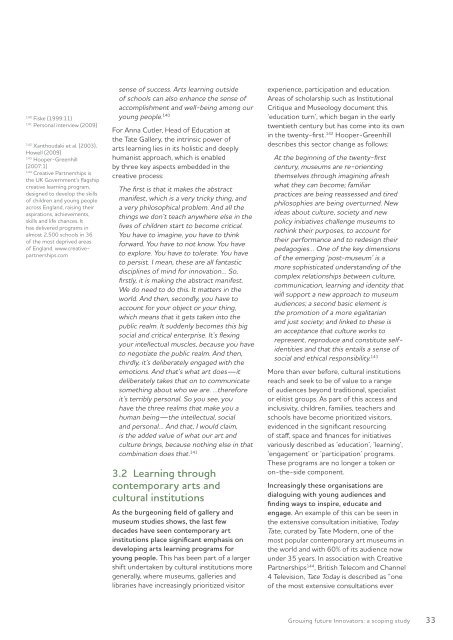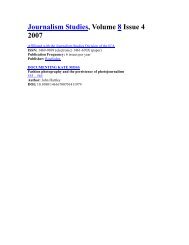GrowinG Future innovators - ARC Centre of Excellence for Creative ...
GrowinG Future innovators - ARC Centre of Excellence for Creative ...
GrowinG Future innovators - ARC Centre of Excellence for Creative ...
You also want an ePaper? Increase the reach of your titles
YUMPU automatically turns print PDFs into web optimized ePapers that Google loves.
140 Fiske (1999:11)<br />
141 Personal interview (2009)<br />
142 Xanthoudaki et al. (2003),<br />
Howell (2009)<br />
143 Hooper-Greenhill<br />
(2007:1)<br />
144 <strong>Creative</strong> Partnerships is<br />
the UK Government’s flagship<br />
creative learning program,<br />
designed to develop the skills<br />
<strong>of</strong> children and young people<br />
across England, raising their<br />
aspirations, achievements,<br />
skills and life chances. It<br />
has delivered programs in<br />
almost 2,500 schools in 36<br />
<strong>of</strong> the most deprived areas<br />
<strong>of</strong> England. www.creativepartnerships.com<br />
sense <strong>of</strong> success. Arts learning outside<br />
<strong>of</strong> schools can also enhance the sense <strong>of</strong><br />
accomplishment and well-being among our<br />
young people. 140<br />
For Anna Cutler, Head <strong>of</strong> Education at<br />
the Tate Gallery, the intrinsic power <strong>of</strong><br />
arts learning lies in its holistic and deeply<br />
humanist approach, which is enabled<br />
by three key aspects embedded in the<br />
creative process:<br />
The first is that it makes the abstract<br />
manifest, which is a very tricky thing, and<br />
a very philosophical problem. And all the<br />
things we don’t teach anywhere else in the<br />
lives <strong>of</strong> children start to become critical.<br />
You have to imagine, you have to think<br />
<strong>for</strong>ward. You have to not know. You have<br />
to explore. You have to tolerate. You have<br />
to persist. I mean, these are all fantastic<br />
disciplines <strong>of</strong> mind <strong>for</strong> innovation… So,<br />
firstly, it is making the abstract manifest.<br />
We do need to do this. It matters in the<br />
world. And then, secondly, you have to<br />
account <strong>for</strong> your object or your thing,<br />
which means that it gets taken into the<br />
public realm. It suddenly becomes this big<br />
social and critical enterprise. It’s flexing<br />
your intellectual muscles, because you have<br />
to negotiate the public realm. And then,<br />
thirdly, it’s deliberately engaged with the<br />
emotions. And that’s what art does—it<br />
deliberately takes that on to communicate<br />
something about who we are. …there<strong>for</strong>e<br />
it’s terribly personal. So you see, you<br />
have the three realms that make you a<br />
human being—the intellectual, social<br />
and personal… And that, I would claim,<br />
is the added value <strong>of</strong> what our art and<br />
culture brings, because nothing else in that<br />
combination does that. 141<br />
3.2 Learning through<br />
contemporary arts and<br />
cultural institutions<br />
As the burgeoning field <strong>of</strong> gallery and<br />
museum studies shows, the last few<br />
decades have seen contemporary art<br />
institutions place significant emphasis on<br />
developing arts learning programs <strong>for</strong><br />
young people. This has been part <strong>of</strong> a larger<br />
shift undertaken by cultural institutions more<br />
generally, where museums, galleries and<br />
libraries have increasingly prioritized visitor<br />
experience, participation and education.<br />
Areas <strong>of</strong> scholarship such as Institutional<br />
Critique and Museology document this<br />
‘education turn’, which began in the early<br />
twentieth century but has come into its own<br />
in the twenty-first. 142 Hooper-Greenhill<br />
describes this sector change as follows:<br />
At the beginning <strong>of</strong> the twenty-first<br />
century, museums are re-orienting<br />
themselves through imagining afresh<br />
what they can become; familiar<br />
practices are being reassessed and tired<br />
philosophies are being overturned. New<br />
ideas about culture, society and new<br />
policy initiatives challenge museums to<br />
rethink their purposes, to account <strong>for</strong><br />
their per<strong>for</strong>mance and to redesign their<br />
pedagogies… One <strong>of</strong> the key dimensions<br />
<strong>of</strong> the emerging ‘post-museum’ is a<br />
more sophisticated understanding <strong>of</strong> the<br />
complex relationships between culture,<br />
communication, learning and identity that<br />
will support a new approach to museum<br />
audiences; a second basic element is<br />
the promotion <strong>of</strong> a more egalitarian<br />
and just society; and linked to these is<br />
an acceptance that culture works to<br />
represent, reproduce and constitute selfidentities<br />
and that this entails a sense <strong>of</strong><br />
social and ethical responsibility. 143<br />
More than ever be<strong>for</strong>e, cultural institutions<br />
reach and seek to be <strong>of</strong> value to a range<br />
<strong>of</strong> audiences beyond traditional, specialist<br />
or elitist groups. As part <strong>of</strong> this access and<br />
inclusivity, children, families, teachers and<br />
schools have become prioritized visitors,<br />
evidenced in the significant resourcing<br />
<strong>of</strong> staff, space and finances <strong>for</strong> initiatives<br />
variously described as ‘education’, ‘learning’,<br />
‘engagement’ or ‘participation’ programs.<br />
These programs are no longer a token or<br />
on-the-side component.<br />
Increasingly these organisations are<br />
dialoguing with young audiences and<br />
finding ways to inspire, educate and<br />
engage. An example <strong>of</strong> this can be seen in<br />
the extensive consultation initiative, Today<br />
Tate, curated by Tate Modern, one <strong>of</strong> the<br />
most popular contemporary art museums in<br />
the world and with 60% <strong>of</strong> its audience now<br />
under 35 years. In association with <strong>Creative</strong><br />
Partnerships 144 , British Telecom and Channel<br />
4 Television, Tate Today is described as “one<br />
<strong>of</strong> the most extensive consultations ever<br />
Growing future Innovators: a scoping study 33




![Plebiscite (Riegert chapter) revised FINAL [Feb 14].pdf](https://img.yumpu.com/8710373/1/190x245/plebiscite-riegert-chapter-revised-final-feb-14pdf.jpg?quality=85)